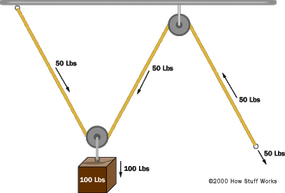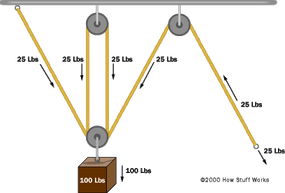How To Use Block And Tackle
If y'all have e'er looked at the end of a crane, or if y'all have always used an engine hoist or a come-along, or if you lot accept e'er looked at the rigging on a sailboat, then you lot have seen a block and tackle at work. A block and tackle is an arrangement of rope and pulleys that allows you to merchandise strength for distance. In this edition of How Stuff Works we will expect at how a block and tackle works, and also examine several other force-multiplying devices!
Understanding the Block and Tackle
Imagine that you accept the arrangement of a 100 pound (45.iv kilogram) weight suspended from a rope, as shown here.
In this figure, if yous are going to suspend the weight in the air so you lot have to apply an upward strength of 100 pounds to the rope. If the rope is 100 anxiety (30.5 meters) long and y'all desire to elevator the weight up 100 feet, you have to pull in 100 feet of rope to do it. This is simple and obvious.
Now imagine that you add a pulley to the mix.
Does this change anything? Not really. The only thing that changes is the direction of the forcefulness y'all have to apply to lift the weight. You still have to utilise 100 pounds of force to keep the weight suspended, and you still take to reel in 100 feet of rope in gild to elevator the weight 100 feet.
The following figure shows the organisation after adding a second pulley:

This arrangement actually does change things in an of import way. You can meet that the weight is at present suspended by two pulleys rather than ane. That means the weight is dissever equally between the two pulleys, and then each one holds just half the weight, or fifty pounds (22.7 kilograms). That means that if y'all want to hold the weight suspended in the air, y'all only have to use 50 pounds of strength (the ceiling exerts the other 50 pounds of strength on the other finish of the rope). If y'all want to lift the weight 100 feet higher, then yous have to reel in twice equally much rope 0- 200 feet of rope must be pulled in. This demonstrates a force-altitude tradeoff. The strength has been cut in half simply the distance the rope must be pulled has doubled.
The following diagram adds a third and fourth pulley to the arrangement:

In this diagram, the pulley attached to the weight really consists of two split up pulleys on the aforementioned shaft, equally shown on the right. This system cuts the forcefulness in one-half and doubles the altitude again. To concur the weight in the air you must utilise only 25 pounds of forcefulness, simply to elevator the weight 100 feet college in the air you must at present reel in 400 feet of rope.
A block and tackle can contain as many pulleys as you similar, although at some betoken the amount of friction in the pulley shafts begins to become a significant source of resistance.
Other Forcefulness/Distance Tradeoffs
Yous come into contact with force/distance tradeoffs in all sorts of simple machines. For example, a lever is an case of this phenomenon:
In this diagram a force F is being applied to the left end of the lever. The left end of the lever is twice equally long (2X) equally the right terminate (X). Therefore on the right end of the lever a force of 2F is available, only it acts through half of the altitude (Y) that the left end moves (2Y). Changing the relative lengths of the left and right cease of the lever changes the multipliers.
Gears can exercise the same thing:
In this diagram the left-hand gear has twice the bore of the correct-hand gear. For every turn of the left-hand gear, the correct-hand gear turns twice. If you use a sure corporeality of torque to the left-paw gear through one rotation, the right-manus gear volition exert half every bit much torque only volition turn two revolutions.
Another practiced case is a elementary hydraulic system, as shown beneath:

Assume that y'all have two cylinders full of water with a pipe connecting the ii cylinders together as shown. If you apply a force F to the left-hand plunger, it creates a pressure level in the left-hand cylinder. Let's say y'all apply a 10 pound downward force to the left-hand cylinder. Let's besides say that the radius of the left-hand cylinder is 0.57 inches. Therefore, the expanse of the left-hand piston is Pi * 0.57 * 0.57 = i square inch. If the radius of the right-paw cylinder is 4 times greater, or 2.28 inches, and so the area of the right-hand piston is sixteen square inches, or sixteen times greater. If yous push the left-paw piston downwardly through 16 inches with a force of 10 pounds, then the right-manus piston will rising 1 inch with a force of 160 pounds. Hydraulic cylinders of all sorts take advantage of this simple strength-multiplying issue every twenty-four hour period.
You tin can see that a block and tackle, a lever, a gear train and a hydraulic organisation all do the same thing: they allow y'all magnify a force by proportionally diminishing the distance through which the magnified force tin can act. It turns out that this sort of force multiplication is an extremely useful capability! Hither are some of the devices that utilise these simple principles:
- Car jack (lever or threaded gear)
- Fingernail clippers (lever)
- Automobile transmission (gears)
- Come-forth (block and tackle, gear)
- Can opener (gear, lever)
- Crowbar (lever)
- Hammer claw (lever)
- Bottle opener (lever)
- Car brakes (hydraulics)
- Hydraulic shop lift
- Elevator (block and tackle)
- Etc...
Originally Published: April 1, 2000
Pulley FAQ
How do pulleys piece of work?
A caster is a bicycle on an axle designed to assist in the movement of heavy loads. A one-cycle pulley allows yous to alter the direction of the force you take to use to lift the load past pulling down to lift a load up. Similarly, a two-bicycle pulley splits the weight equally and so that each holds just half the weight, allowing you to lift the same weight with half of the force.
Where are pulleys used?
Pulleys have diverse applications across many industries. Mutual examples include construction pulleys, which are used to lift and movement heavy materials; theatre curtains and window blinds; and a lot of exercise equipment.
Is a crane a pulley?
A crane is a machine that uses pulleys and cables to elevator, motility and lower heavy materials. While cranes exercise use pulleys for their main role, they themselves are not pulleys.
Lots More Information
How To Use Block And Tackle,
Source: https://science.howstuffworks.com/transport/engines-equipment/pulley.htm
Posted by: coxource1977.blogspot.com


0 Response to "How To Use Block And Tackle"
Post a Comment